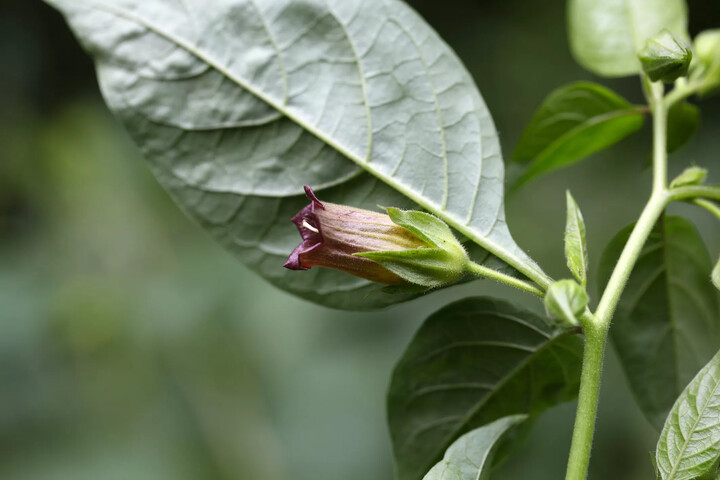Belladonna is extremely toxic to humans, cats, dogs, and horses. By no means should you ever plant it in your yard. Because the plant has escaped its native areas in Eurasia and has naturalized in other parts of the world, it is important to be able to identify it. In the United States, belladonna has been found in several states, including New York, Michigan, California, Oregon, and Washington. It often grows in wasteland and areas with disturbed soil such as dumps and quarries, but also along roadsides.
The botanical name of the genus actually gives away how deadly the plant is. Atropa was named in the mid-1700s after Atropos, the Greek goddess who, as one of the three goddesses of fate and destiny, holds the shears to cut the thread of life. The common name and the species name, belladonna, comes from the Italian word for beautiful woman, “bella donna”. Ladies at the Venetian court used eye drops made of belladonna to dilate their pupils, viewed as a sign of special beauty at the time.
Botanical Name:
Atropa bella-donna
Common Name:
Belladonna, deadly nightshade
Plant Type:
Perennial
Mature Size:
Three to four feet height and width
Sun Exposure:
Full sun, part shade
Bloom Time:
June through early September
Flower Color:
Purple/lavender
Native Area:
England through central and southern Europe, North Africa to Iran
Toxicity of Belladonna
All parts of the plant—leaves, flowers, fruits, and roots—are highly toxic, not only when ingested but also when the toxins enter the body through open wounds, cuts, or abrasions. In healthy skin, contact with any part of the plant can cause severe allergic reactions.
Belladonna contains toxic tropane alkaloids such as atropine, scopolamine, and hyoscyamine. Symptoms of belladonna poisoning are dilated pupils, rapid heartbeat, delirium, vomiting, hallucinations, and respiratory failure leading to death.
Due to their slight resemblance with wild edible berries, such as blueberries and blackberries, the purplish-black, sweet-tasting fruit of belladonna pose a particular risk of being ingested. As little as two berries for a child and ten berries for an adult can be lethal.
Belladonna is also highly toxic and lethal to dogs, cats, horses, and other domesticated animals. It is not toxic to birds and other animals.
The honey from belladonna is also toxic
When honeybees feed on belladonna, the honey they produce can contain significant amounts of atropine, which also makes the honey poisonous.

Identifying Belladonna
Belladonna is an upright, branched perennial of the nightshade family. The dark green leaves are oval, pointed and unevenly sized, ranging from three to ten inches in length. The plant has simple, alternate leaves.
The dull purple flowers, which appear as single flowers in the leaf axils, are distinctly bell-shaped and mildly fragrant. The fruit, which ripen between late August and September, are black and shiny like a cherry.
Belladonna spreads rapidly like a weed and dies back during the winter. In the spring, it will regrow from its thick, fleshy roots.
If you have positively identified belladonna in your yard, take all the necessary precautions to avoid skin contact, and safely dispose of the entire plant including its roots in the trash.
Uses of Belladonna in History
Because of its highly toxic properties, belladonna has been deliberately used as a weapon and poison throughout history. Romans contaminated the food reserves of their enemies with it. In 1030 the Scottish King Duncan used it to defeat the Danes without the use of force by giving them belladonna to drink and inducing a coma, a story that inspired Shakespeare’s Macbeth.
In the Second World War, atropine sulphate was administered as an antidote to nerve gas, and given to troops so they could inject themselves in case of an attack.
Up until the early to mid-twentieth century, belladonna was used to treat a variety of conditions including neuralgia, chronic rheumatism, muscle and back pain, and pulmonary tuberculosis.

Uses of Belladonna Today
In optometry and ophthalmology, atropine derived from belladonna is used to dilate a patient’s pupils for eye-exams and surgery.
While belladonna is not regulated by the FDA, it is an active ingredient in many homeopathic remedies such as lotions, plasters, and salves for pain relief, and to treat inflammatory bowel disease, asthma, and other conditions.